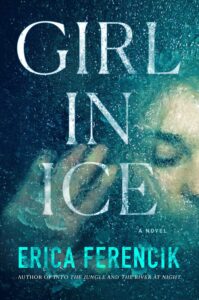Welcome Erica. We’re excited to have you on our blog today!
How about we start with learning a bit about you? Where are you from, where do you live and is writing your full-time job?
I was raised in the wilds of upstate New York during the era when—rightly or wrongly—you could take off after school to explore and no one worried, as long as you were home by dark. Now, I live in MetroWest Boston with my very tolerant husband and frankly enormous Maine Coon cat. Writing – I’m happy and grateful to say – is now my full-time job.
How long have you been writing?
I’ve been writing for over thirty-five years. In my late twenties I started out with novels, but my enthusiasm didn’t match my skill set, so four or five went into the drawer. I went on to get my Masters in Creative Writing from Boston University, but I consider that just the beginning of being able to really tell a story. Over the years I wrote short stories, essays, ghostwrote several books, did ten years of standup and sketch comedy, penned screenplays, even dove into a brief filmmaking stint. I consider all these adventures my boots-on-the-ground training for the writer I am today.
Give us a peek at your typical writing day.
Mornings are spent “taking care of business” – errands, emails, exercise, you name it, life stuff. I settle down in my studio – a very simple, small rehabbed shed behind my house – at around three pm. I bring my dinner in there and work till nine p.m. five or six nights a week, seven when I’m behind or on some crazy deadline. The shed looks out over the woods behind our property and I’m so grateful to have it. All sorts of animals have dropped by to see me as I work: deer, rabbits, coyotes, skunks, owls, porcupines, and I’m delighted to see them all.
Tell us about your latest release.
Girl in Ice just released on March 1, 2022.
Valerie “Val” Chesterfield is a linguist and professor trained in the most esoteric of disciplines: dead Nordic languages. Despite her successful career, Val leads a sheltered life and languishes in the shadow of her even more accomplished twin brother, Andy, a climate science researcher stationed on a remote island off Greenland’s barren coast.
One night, Andy ventures out, nearly naked, in 50 degree below zero weather and dies by apparent suicide. Val is both inconsolable and disbelieving; she suspects foul play.
Months pass. When Wyatt, Andy’s fellow researcher in the Arctic, discovers a scientific impossibility – a young girl frozen in the ice who thaws out alive, speaking a language no one understands – Val is his first call. Would she travel to the frozen North and meet this girl, try to comprehend what she is so passionately trying to communicate?
Under the guise of helping Wyatt interpret the girl’s speech, Val musters every ounce of her courage and journeys to the Artic to solve the mystery of her brother’s death.
The moment she steps off the plane, everything is as Val feared: the landscape is fierce, and Wyatt is an enigma. But the girl is special, and soon she becomes like the daughter Val never had.
Only something is terribly wrong; the girl is sick, and the key to saving her lies in discovering the truth about Wyatt’s research (and her brother’s involvement and subsequent death). With time running out, Val embarks on an incredible frozen odyssey – led by an unlikely guide – to rescue the new family she has only just found in the most unexpected of places.
What inspired this book?
One bitterly cold morning in the winter of 2018, I was walking in the woods near my home, and came upon three juvenile painted turtles frozen mid-stroke in the ice along the shallow edge of a pond. They didn’t look alive, but they didn’t look dead either.
It turns out there are some animals (and plants too!) that have this freezing-and-coming-back-to-life thing down. Painted turtle hatchlings, some species of beetle, wood frogs, certain alligators, and even an adorable one-millimeter length creature called a Tardigrade or “water bear” that can be frozen to -359C and thaw out just fine. Most of these creatures possess a certain cryo-protein that protects their cells from bursting when they freeze.
A protein that…we don’t possess. Still, the image of a young girl frozen in a glacier in the Arctic popped into my head. From there, I asked myself: How did she get there? What was her story?
Can you share a detail from your current release with readers that they might not find in the book?
During my month-long research trip to Greenland, a small band of explorers and myself kayaked with our native guide into a section of a fjord known as the Iceberg Graveyard, where – because of quirks in ocean currents – thousands of giant ice floes gather until summer, when most melt away.
All around us, jaw-droppingly strange bergs loomed only hundreds of yards away. Some soared ten stories high, all carved into impossible shapes: eerie cathedrals, massive arches, a bulbous monster two city blocks long, scored and warped by the waves.
I asked my guide what would happen if one of these split or calved. He said we’d all have to turn our kayaks toward the sound – fast – in order to keep from being flipped into the icy waters by the mammoth waves that would form. Heart pounding, I thought what am I doing here, then took my cue from the others, each of them calmly gliding along between the ice monsters, listening.
What has been your hardest scene to write?
If I have trouble writing a scene, it’s usually because I haven’t thought it through well enough. I have to go back and ask myself, why is this scene here, really? What work does it do? And most importantly, where is the conflict?
So – I have a way of dealing with even the most difficult scenes. It’s the first and last chapters that nearly kill me. They are responsible for countless hours of me staring into space, tossing in the towel for the day, pouring a glass of wine or going for a walk, or both.
The first chapter – the first page – has to do a massive amount of work for the reader: offer up an irresistible hook while giving just enough sense of who, what, when, where, and why to entice them, while not dumping in a lot of backstory.
Last chapters drive me nuts because the climax of the story has happened by that point (for most books) and there is the problem of how to wrap this puppy up. I find it so difficult to tread the delicate balance between wrapping story elements up too neatly, and leaving a few elements to the reader’s imagination – without frustrating them with too little information.
Who has been the most difficult character for you to write?
In Girl in Ice, there is a child named Sigrid who has thawed out alive from a glacier speaking a language familiar to no one. Without giving too much away, she is a child who has her own language, but is too frightened and traumatized to trust those around her enough to even attempt to communicate. It was so difficult to convey her personality without her speaking a word of English. More than that, it was challenging to create a character who’d had a life so completely foreign from my own.
If you could be one of your characters for a day which character would it be? Why?
Ironically, it would Sigrid!:) I would love to see the world from her perspective, to know the things she knows about surviving in her world, her culture, even to experience what it would be like to wake in an entirely different world from my own.
What authors that have influenced how you write ?
Hundreds of authors have fired me up over the decades. Here’s a woefully incomplete list: Claire Messud, Ian McEwan, Audrey Audrain, Helen Phillips, Ian McGuire, Hernan Diaz, Joe Hill, Sabina Murphy, Donna Tartt, Sarah Waters, Sally Donahue, Daphne du Maurier, Lionel Shriver, Nathan Ballingrud, Muriel Spark, Robert Goolrick, Tobias Wolff.
From these authors and countless others, I’ve learned about: pacing, point of view, how to construct a scene, dialogue, timing, reversals, story structure, voice, and countless other skills necessary to write a compelling novel.
Tell us your favorite under-appreciated novel?
Stoner, 1965, by John Williams, though lately this book has been getting some love, so I feel a little better.:)
Do you have a secret talent readers would be surprised by?
I’ve been a dancer all my life, and used to teach some basic jazz and ballet classes. I still take classes four or five times a week: it keeps me sane. It also literally makes it possible for me to sit the many hours necessary in order to write books.
Your favorite go to drink or food when the world goes crazy!
I love Lillet too much, and pinot noir is another bestie.
Most all food is welcome in my home and in my belly, but there’s nothing like a really good pizza when the day has tapped my dry.
And what is your writing Kryptonite?
Persistence, and the belief that I have something to offer the reader.
What is the one question you never get asked at interviews, but wish you did? Ask and answer it.
What advice would you give writers today?
No matter how your work is being received, love yourself at every stage of your writing life. I sure wish I had been kinder to myself.
I took rejection hard over the decades before my first novel was published. And trust me, the demons still want in. There are days I beat myself up for perceived shortcomings more than I actually write. I castigate myself for not being able to produce when it’s time to produce, for creating words, sentences – entire stories – that don’t live up to what I’d conjured so clearly and beautifully in my head. So, see? I don’t always live by my own advice. Hell, I even beat myself up for beating myself up😊.
But here’s what I’ve learned:
Each cell in your body replaces itself every seven to ten years. It stands to reason that you will literally be a different writer in your twenties, thirties, forties, fifties and beyond. Each writer you were, are, or will become, is important, valid and frankly wonderful. Sure, we’ve all got the stories – maybe even whole novels – shoved in the drawer, but without having written them, it’s quite possible you couldn’t have moved on to what you’re working on these days, and admit it: you love what you’re working on now, right? And who knows? Maybe – in one of those squirreled-away manuscripts – an idea for a new novel or screenplay lurks, some key to the opus you were born to write. It happens all the time. It happened to me.
So, don’t be such a beeyatch to yourself. Would you treat a friend like that? Of course not. Now have a cookie.
Wow, what great advice! Thank you so much for joining us today!
Learn more about Erica and her books by visiting her webpage
Here’s a peek at Erica’s latest release GIRL ON ICE:
 From the author of The River at Night and Into the Jungle comes a harrowing new thriller set in the unforgiving landscape of the Arctic Circle, as a brilliant linguist struggling to understand the apparent suicide of her twin brother ventures hundreds of miles north to try to communicate with a young girl who has been thawed from the ice alive.
From the author of The River at Night and Into the Jungle comes a harrowing new thriller set in the unforgiving landscape of the Arctic Circle, as a brilliant linguist struggling to understand the apparent suicide of her twin brother ventures hundreds of miles north to try to communicate with a young girl who has been thawed from the ice alive.
Valerie “Val” Chesterfield is a linguist trained in the most esoteric of disciplines: dead Nordic languages. Despite her successful career, she leads a sheltered life and languishes in the shadow of her twin brother, Andy, an accomplished climate scientist stationed on a remote island off Greenland’s barren coast. But Andy is gone: a victim of suicide, having willfully ventured unprotected into 50 degree below zero weather. Val is inconsolable—and disbelieving. She suspects foul play.
When Wyatt, Andy’s fellow researcher in the Arctic, discovers a scientific impossibility—a young girl frozen in the ice who thaws out alive, speaking a language no one understands—Val is his first call. Will she travel to the frozen North to meet this girl, and try to comprehend what she is so passionately trying to communicate? Under the auspices of helping Wyatt interpret the girl’s speech, Val musters every ounce of her courage and journeys to the Artic to solve the mystery of her brother’s death.
The moment she steps off the plane, her fear threatens to overwhelm her. The landscape is fierce, and Wyatt, brilliant but difficult, is an enigma. But the girl is special, and Val’s connection with her is profound. Only something is terribly wrong; the child is sick, maybe dying, and the key to saving her lies in discovering the truth about Wyatt’s research. Can his data be trusted? And does it have anything to do with how and why Val’s brother died? With time running out, Val embarks on an incredible frozen odyssey—led by the unlikeliest of guides—to rescue the new family she has found in the most unexpected of places.
You can purchase GIRL ON ICE at:
AMAZON: https://www.amazon.com/Girl-Ice-Erica-Ferencik/dp/1982143029
INDIEBOUND: https://www.indiebound.org/book/9781982143022
BOOKSHOP: https://bookshop.org/books/girl-in-ice-9781797130194/9781982143022






